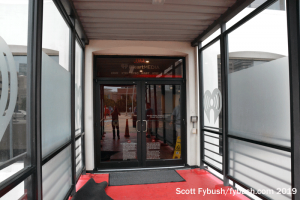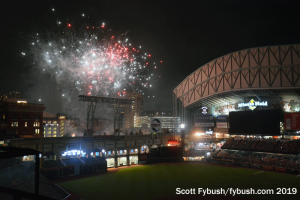NorthEast Radio Watch 12/8/2025: Cichon’s Back in Buffalo
In this week’s issue… Veteran newsman returns - Remembering NY's Leitner, RI's Jones - CT AM saved - Maine AM moves - "Indie" adds suburban signals
Text and photos by SCOTT FYBUSH
Are we spending a lot of time here on Site of the Week showing you the sights (and sites) of Houston, as we continue recapping our last “big trip” from September 2019?
We are – but if you’re a veteran Site of the Week reader, or if you’ve spent time catching up on our voluminous archives (now approaching 20 years and nearly 1000 of these segments!), you’ve seen many deep dives into the histories of nine of the top 10 markets. Want to see inside almost everything in New York, Los Angeles or Boston? We’ve been there… and inside lots of studios and transmitter sites in Chicago, San Francisco, Philadelphia, Chicago and Atlanta, too. And if you haven’t had your fill of Dallas-Fort Worth here, there’s more from 2019 coming on that front, too.


But Houston? Houston was new turf for us, and so we hope you’ll forgive us for indulging in showing you as much as we could fit into three packed days on the bayous there.
That includes some stops we never even expected to make. We didn’t plan on stopping by iHeart’s Houston studios, but with a little time to spare after our trips out to Missouri City and the KILT 610 sites with Entercom’s Robbie Green, he suggested calling his colleague Bob Stroupe and making a quick studio visit at the end of the afternoon before we returned to the Entercom studios to pick up our car and head for… well, you’ll see where the evening ended up, too.


For a market that’s famous for both its sprawl and lack of zoning, it’s interesting to see how closely so many broadcast studio facilities ended up clustering closely to each other. Within less than a mile of the interchange of the I-610 west loop and I-69/US 59 (the Southwest Freeway) on the west side of Houston, you’ll find the office buildings that house the studio clusters for Entercom, Radio One, Cox, Cumulus and most of Houston’s TV stations, too.
And, yes, you’ll find iHeart here, just off the west side of 610 in a skinny office tower with a big parking ramp behind it. Follow the signs all the way to the top of the ramp and there’s a covered bridge that bypasses the main building lobby and takes you right into the third-floor iHeart lobby.



But don’t linger on the third floor very long (though there is a nice display of guitars in front of the station lounge area here); while there are sales and executive offices here, all the studio action requires an elevator ride upstairs.
This facility bears a close resemblance to other studio plants built by Clear Channel in the early 2000s: like its big facilities in Los Angeles and Denver, it’s constructed with pods for either one or two stations, each with an air studio and a production room, leading off short hallways from the main corridor.
In this case, it was 2004-2005 when Clear Channel consolidated what were then three AMs and five FMs from multiple sites around Houston, the result of several intense years of cluster-building that brought together pieces of the original Clear Channel (KPRC 950), Jacor via Nationwide (KKRW 93.7 and KHMX 96.5), and SFX/AMFM/Chancellor (KTRH 740, KBME 790, KTBZ 94.5, KODA 99.1 and KLOL 101.1).


Six of those eight stations are still here, after two of them (KHMX and KLOL) were spun away to then-CBS Radio in 2009 in a multi-market swap between CBS and Clear Channel. The FM end of the studio hallway has two studio pods, one for modern rock “Buzz” KTBZ, the other shared between AC KODA and hip-hop “Beat” KQBT, the former KKRW.



It’s all SAS consoles and (of course) RCS automation in these rooms, with windows looking out over the traffic on the 610 loop, if they’re not closed against the hot Texas sunshine, as most of them are on this September afternoon.
This cluster resembles its sisters in Denver and LA in another way, too, with a heavier AM presence than is typical these days for iHeart.
As we work our way down to the AM side of the floor, there’s a studio pod for the big all-sports signal here, KBME (790), home of the Astros, Rockets and live, local sports talk most of the day.
(There’s an Astros connection here that I bet most of the SportsTalk 790 hosts don’t even know: 790’s origins are as KTHT, which started after World War II as one of many projects of the ambitious Roy Hofheinz, who owned the Colt .45s, the team that became the Astros. Hofheinz built the Astrodome, and had a lavish apartment inside the dome.)


If KBME has history, its two AM sisters here have even more: at the other end of the hall, a long hallway leads to the control rooms and studios of Houston’s two oldest radio stations.
KPRC (950) is the oldest surviving Houston station of them all, dating to 1925 and the early radio efforts of the Houston Post, which had been involved in earlier short-lived stations as well. It remained in the hands of the Hobby family until 1993, then spent two years under local ownership paired with a newer talker, KSEV (700), before Clear Channel bought it in 1995. In recent years, it’s been something of an extra wheel, clearing iHeart’s Premiere talk content and some leased-time talk; of late, it’s also been used to originate the syndicated Walton & Johnson morning show that’s heard on stations around the Southeast.
(One more fun historical note: when this cluster came together, it reassembled KPRC and the original KPRC-FM, which had become KHGM and then KODA after the Post sold the FM to Taft Broadcasting in 1958; in later years, it was part of Westinghouse’s FM group before making its way through SFX and AM/FM to Clear Channel in 1999.)


KPRC’s bigger AM sister is newer in Houston, though arguably older in its roots: KTRH (740) actually started in Austin in 1922 as WCM, then became KUT in 1925 before being moved to Houston and the Rice Hotel in 1929. (Austin later had two more stations called KUT, the first an AM that was moved from San Antonio and the second being the noncommercial FM that is still located on the UT campus.)
KTRH ramped up to 50,000 watts after World War II, when it moved from 1320 to 740, becoming the big news station in town (its staffers included a young Dan Rather) and a cornerstone of the CBS network. Along with sister station KLOL, it was bought by Evergreen in 1993, the first step along the way to its eventual consolidation into Chancellor, Clear Channel and now iHeart.


The KTRH studio occupies pride of place on the south corner of the building, with a big newsroom just down the hall supplying news to KTRH, KPRC and several smaller iHeart markets around Texas and Louisiana, too.
And no, we didn’t get to see KTRH’s transmitter; while the weather we experienced in Houston was just the usual muggy dampness, our arrival in town came just a few days after a bigger storm had hit just to the east, making the transmitter plant way out east of Houston in Dayton, Texas unreachable this time around. (Next time, for sure!)


From here, we headed back to our car at the Entercom studios, passing by the row of iHeart promo vehicles out on the parking deck here, and then waving hello to the Univision studio building that’s prominent right by the 610/Southwest Freeway interchange.
(This building is home to the company’s two TV stations, Univision outlet KXLN 45 and Telefutura’s KTFH 67, plus a radio cluster that includes KLTN “Que Buena” 102.9, “Latino Mix” KAMA-FM 104.9/KQUE 93.3, “Amor” KOVE-FM 106.5 and sports talk KLAT 1010.)


So where were we headed on our first full evening in Houston? To see some baseball, of course, checking off Houston’s downtown Minute Maid Park as our 27th active MLB park. (Oh, for the days when we could travel places and go to ballgames!)


The roof was closed when we got there, making for a suprisingly cozy experience up above home plate in this oddly rectangular ballpark; the seating stretches out largely along the first-base side and out into right field, while the third-base line is shorter and there’s a long wall along left field lined by windows, ads and a faux train track.
The Astros prevailed over the As in this late-season game, and the roof opened (after some technical delays) for fireworks over downtown Houston.
And if you’ve enjoyed the last four installments… that’s just one day in Houston! Come back next week as we hit the road to get some quicker looks at many of the other sites all around this huge and exciting market. (And eat some Whataburger, too, because when in Texas…)
Thanks to iHeart’s Bob Stroupe for the tours!

As we announced a few weeks ago, the 2026 edition of the Tower Site Calendar will be the last.
We began publishing it 25 years ago, and the broadcast landscape is radically different now.
Radio World just ran an excellent article about us if you want to know more.
Once it’s gone, that’s it. We won’t be printing any more.
Thank you to everyone who saw our announcement and rushed to buy it. We appreciate you.
(There are some calendars from previous years if you want more of a tower photo fix — all under $5.)
But don’t wait to get this year’s Tower Site Calendar — buy it now!
We are selling the Broadcast Historian’s Calendar again this year, but we have that in an even smaller quantity — definitely don’t hesitate for that.
And visit the Fybush Media Store to check out our selection of books and videos, too!
And don’t miss a big batch of Houston IDs next Wednesday, over at our sister site, TopHour.com!
Next week: Still more Houston!
In this week’s issue… Veteran newsman returns - Remembering NY's Leitner, RI's Jones - CT AM saved - Maine AM moves - "Indie" adds suburban signals
In this week’s issue… Scripps stations face takeover - Sinclair moves more affiliations - CT stations sold - Maine AM surrendered - Remembering WVBR's Shapiro, WABC's Morgan
In this week’s issue… CT TV legend succumbs to cancer - Remembering PA's Adams - FCC still stalled by shutdown - Pittsburgh morning host exits
In this week’s issue… FCC faces reopening challenges - Veteran Boston anchor retires - Morning shift in Toronto - NYC FMs expand reach